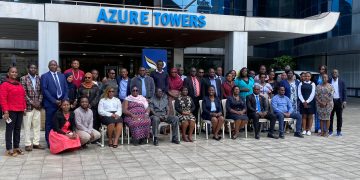Children still face inequities in Tuberculosis (TB) response, with most still at high risk of sickness and death compared to adults because of missed diagnosis.
According to Dr Caren Mburu, Paedritician and senior technical advisor for adolescent and paedriatic services at Elizabeth Glasier Paedriatic Aids Foundation (EGPAF), Kenya misses around 44 percent of children with TB cases every year.
She cites the Division of National Tuberculosis, Leprosy, and Lung Disease Program (DNTLD-P) annual prevalence report 2021, which states that prevalence of 9 percent among children under the age of 14. However, she says that national data reveals that the true prevalence of childhood TB is around 10 to 15 percent.
She partly explains why we still have gaps in diagnosing and treating TB in young children saying that “TB in children presents differently compared to adults, the symptoms of TB in adults is fairly well described, leading to definitive diagnosis and treatment. But TB in children can easily be missed the awareness that they might be having T.B. is also low. This is because the symptoms are similar to other childhood illnesses. As a result, diagnosis and treatment are delayed and sometimes missed.”
Dr Mburu was speaking in Nairobi at the 1st Africa TB Experts Meeting hosted by Stop TB Partnership Kenya and supported by Qiagen.
The two-day meeting brought together experts from more than 15 countries in the African region, Pakistan among others countries to take stock of the progress made in the fight against TB on the continent.
Dr Mburu further explained that a lot of childhood TB diagnosis still rely on clinical examination and sputum smear microscopy, which with children is even more difficult – as children don’t produce sputum when they cough.
Diagnosing TB in children is difficult for a number of reasons, bacteriological diagnosis is the most ideal way to diagnose, However many areas (not just rural) don’t have access to these services.
Multi-drug resistant TB (MDR-TB) in children is also hugely underestimated, Dr Mburu said, with 2.4 percent of children with drugs resistance TB.
She also noted that a lot of factors compound children’s vulnerability to TB, including poor nutritional status which makes the child’s immunity less and hence prone to attack by the disease.
“We also have a population of children living with HIV and that is double vulnerability because they are children and then they are living with HIV so that increases their vulnerability,” Mburu noted.
According to the World Health Organization (WHO), progress in the provision of TB Preventive Treatment (TPT) to eligible children also remains slow, with less than a third of eligible child contacts under the age of 5 receiving TPT in 2021.
Similarly, most of the children come from families living below the poverty line. This does not only affect their nutritional care, some find themselves in settings where they share a room with an adult with TB.
“Poverty dictates the nutritional care you have; it dictates living circumstances; imagine a child in an informal settlement in a one-roomed house with inadequate ventilation and many people in that house. That child is at higher risk of TB,” she noted.
The Experts argue that ignoring the burden of childhood TB can be one of the indications of a failing TB control program in any setting.
According to Professor Lisa Ombimbo, a consultant Pediatrician at the Kenyatta National Hospital, Paedriatic T.B and Latent TB Infections acts as a future reservoir for TB disease, any successful TB control program should include a paediatrics focus.
“We need to close the tap by eliminating additional paedriatic reservoir for TB which is vital to elimination, by identifying paedriatic latent TB infections.”
Epidemiologist Dr Aamir Khan, presenting on the comprehensive solutions for T.B elimination in Pakistan, proposed that the country should publicly adopt the use of IGRA technologies to help pick up asymptomatic TB earlier on before they become symptomatic and that this approach will help in initiating TPT to those already tested.
He argues that using IGRA can help countries to ensure that everyone tested receives TPT.
The Interferon Gamma Release Assay (IGRA) test is a blood test used to see whether a person has been exposed to tuberculosis (TB) bacteria. The IGRA test is used to diagnose TB infection. This is when the TB bacteria is in the body but the person is not experiencing any symptoms suggestive of TB disease. Qiagen’s offers QuantiFERON-TB Gold Plus (QFT-Plus)- a blood test (IGRA).
Dr Mburu was presenting EGPAF Kenya’s Catalyzing Pediatric Tuberculosis Innovation (CaP TB) project study results which was meant to develop and implement models to improve case detection for active pediatric TB disease as well as access to TB preventive therapy (TPT).
Dr Mburu said that important missed opportunities to prevent TB in children include the failure to find and appropriately manage adult source cases and the failure to completely evaluate and properly treat children exposed to TB.
She said that using community health workers to help do proper advocacy at the community level through development of contextual information, education, and communication materials on childhood TB can increase the uptake of pediatric TB services and thus contribute to increased pediatric TB case finding, treatment, and prevention.
The CaPTB study recommends use of lay providers to provide contact screening and family-centered approaches as an important part of reducing the burden of TB in childhood.
The study’s implementation ensured adoption of algorithm-based scoring systems that health care workers can use to inform their decisions when diagnosing the disease, which is often difficult to identify in Paedriatic population.
World Health Organization also recommends the use of algorithms in its latest consolidated guidelines for treating childhood and paedriatic T.B.
According to National Coordinator Stop TB Partnership Kenya Everlyn Kibuchi, Kenya still faces the challenge of getting everybody who has been infected with TB going for diagnosis and being put on treatment, with about 49 per cent of people who have TB still walking in the streets without having been diagnosed and being treated and about 90 percent having latent T.B.
The experts called for innovative methods and evidenced-based approaches by use of big data to model impacts of reduction of reservoir of future T.B burden by use of IGRA vs TST and also in reduction of missed cases and initiating them in TPT.














